|
|
ARTHROPODS:
Insects»
Spiders»
Centipedes»
Millipedes»
Sowbugs»
Harvestmen»
Mites
& Ticks»
Scorpions»
Identification
Tips»
About
the Critter Files»
Links» |
|
|
|
 |
SCORPIONFLIES
&
HANGINGFLIES
Critter
Files/Insects/Scorpionflies
By Blake Newton
University of Kentucky Department of Entomology |
| |
|
| |
| TAXONOMY |
KINGDOM: Animalia
| PHYLUM: Arthropoda | CLASS: Insecta | ORDER: Mecoptera (Scorpionflies
& Hangingflies) |
| |
WHAT
IS A SCORPIONFLY?
LIFE CYCLE
ECOLOGY
PEST STATUS
COMMON KENTUCKY SCORPIONFLIES & HANGINGFLIES
COLLECTING & PHOTOGRAPHY
SCORPIONFLY & HANGINGFLY FACTS
MYTHS, LEGENDS, AND FOLKLORE |
| |
| Other
Names: Mecopterans, Panorpids (Scorpionflies), Bittacids
(Hangingflies), Hanging Scorpionflies (Hangingflies) |
| |
| WHAT
IS A SCORPIONFLY? |
|
| "Scorpionfly"
is the common name for insects belonging to the family Panorpidae
within the order Mecoptera. All adult scorpionflies have chewing
mouthparts. Most scorpionflies also have 4 wings, although individuals
belonging to the rare "Snow Scorpionfly" family (Boreidae)
have no wings. Scorpionflies can be easily recognized by the
long "rostrum," at the end of which are the mouthparts (pictured
below). |
|
 Long rostrum
of a scorpionfly (B. Newton, 2005)
Long rostrum
of a scorpionfly (B. Newton, 2005) |
|
| Scorpionflies are named
because of the external male genitalia which resemble the stingers
of scorpions. Scorpionflies cannot sting. Females do not
have this structure. |
| |
| Hangingflies
are in the same order (Mecoptera) as scorpionflies, but they belong
to their own family (Bittacidae). They resemble scorpionflies
in many ways (they are sometimes called "hanging scorpionflies")
but are distinguished by their long, "raptorial" (prey-catching)
legs. |
| |
Like all insects, scorpionflies
and hangingflies have 3 body parts, 1 pair of antennae, and 6 legs.
Scorpionfly and hangingfly
larvae resemble moth caterpillars. They are rarely seen, but
they are common in Kentucky. |
|
| SIZE:
Body length of adult scorpionflies up to 3/4" long, adult hangingflies
are up to 1" long |
| |
| LIFE
CYCLE |
|
Scorpionflies
and hangingflies have complete metamorphosis with egg, larval, pupal,
and adult stages. Adult female scorpionflies lay small masses
of eggs in soil. When they hatch, larval scorpionflies live
and grow near the soil-layer before pupating in underground cells.
Pupae are the overwintering stage. Adults emerge and
mate in summer. Hangingflies have a similar life-cycle, but
females lay their eggs in moss.
|
| |
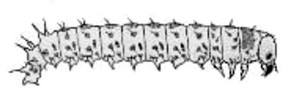 Drawing of a
Scorpionfly Larva (from Miyake 1912, Tokyo
Drawing of a
Scorpionfly Larva (from Miyake 1912, Tokyo
Journal of the College of Agriculture. Vol. 4, 117-139) |
| |
| An illustration
of the scorpionfly life-cycle can be seen here
in a page from a historic entomology textbook. |
| |
| ECOLOGY |
|
|
There are several species
of scorpionflies in Kentucky, and their biology is not well known.
Adult scorpionflies of most species are believed to feed on
dead insects, nectar, rotting fruits, and other organic matter.
Some scorpionflies may be predatory on live prey, especially
wounded or slow-moving insects. Scorpionflies are found in
meadows, especially near the forest-edge. As with the adults,
the habits of larval scorpionflies are not well-known. Many
species are believed to be scavengers and opportunists, feeding
on dead insects and decaying organic material.
Hangingflies are predators
that feed on caterpillars, mosquitoes, flies, moths, and other flying
insects. As their name suggests, hangingflies hang and wait
in ambush for prey. They use their long, clawed legs to capture
insects that get too close. Hangingflies hunt in grassy areas,
meadows, and along sheltered cliff-lines. Larval hangingflies
are believed to be predators. |
| |
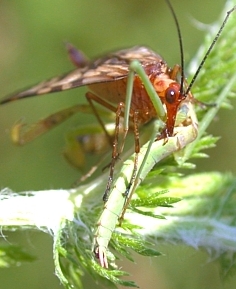 Scorpionfly feeding
on a juvenile
Scorpionfly feeding
on a juvenile
mantid (B. Newton, 2005) |
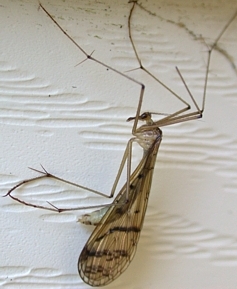 Hangingfly waiting
for prey
Hangingfly waiting
for prey
(B. Newton, 2005) |
| |
| PEST
STATUS |
|
Scorpionflies
are not pests and they do not bite or sting. |
| |
| COMMON
KENTUCKY SCOPRIONFLIES & HANGINGFLIES |
|
|
SCORPIONFLIES
FAMILY: Panorpidae
| GENUS: Panorpa
The
only "true" Scorpionflies in Kentucky
belong to the family Panorpidae and the genus Panorpa.
There are several species in this genus, but they are all
similar in size and shape with bold orange-and-black patterns. Kentucky
scorpionflies are typically about 1/4"-1/2" long. They
are very common in early summer in weedy areas near the forest edge.
|
| |
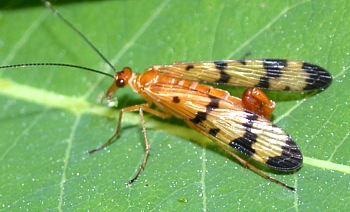 Male Scorpionfly,
Panorpa sp. (B. Newton, 2005)
Male Scorpionfly,
Panorpa sp. (B. Newton, 2005) |
|
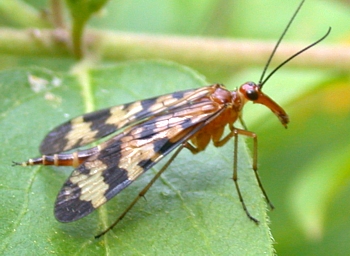 Female Scorpionfly,
Panorpa sp. (B. Newton, 2005)
Female Scorpionfly,
Panorpa sp. (B. Newton, 2005) |
|
|
|
HANGINGFLIES
FAMILY: Bittacidae
| GENERA: Bittacus and Hylobittacus
Hangingflies
are common in Kentucky but they are rarely noticed, probably because
they look similar to common crane
flies. They can be distinguished from crane flies by the
number of wings: crane flies have 2, hangingflies have 4. Kentucky
hangingflies are typically a little less than 1" long. Most
hangingflies found in Kentucky (like the one pictured below) belong
to the genus Bittacus. Hangingflies in the genus
Hylobittacus are similar but do not fold their wings over
their abdomens when resting. |
| |
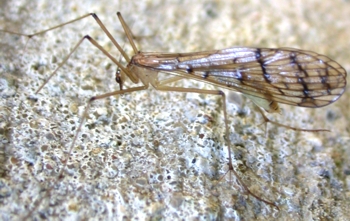 Hangingfly, Bittacus
sp. (B. Newton, 2005)
Hangingfly, Bittacus
sp. (B. Newton, 2005) |
|
| |
| COLLECTING
& PHOTOGRAPHY |
|
In early summer, scorpionfly
adults are abundant and easy to find in Kentucky. Look in
weedy habitats near the edges of forests. Scorpionflies are
not fast flyers, so they are usually easy to capture with an insect
net. However, a scorpionfly will not always remain still if
you are approaching with a camera. Instead, it will often
fly a few feet away and continue this pattern as you try to get
close enough for a good picture.
Hangingflies are difficult
to find consistently. Search for them in summer with a sweep
net in weedy habitats, or look for them hanging under leaves or
rocky overhangs. If you find one hanging, it will likely remain
still for a photograph if it is not touched or disturbed. |
| |
| SCORPIONFLY
& HANGINGFLY FACTS |
|
Snow Scorpionflies
belong to the family Boreidae. They resemble "true"
scorpionflies (family Panorpidae) but they are wingless. Snow
scorpionflies live at high altitudes and are sometimes seen moving
on the snow in large numbers in early spring when snow is still
on the ground. They are not common in Kentucky. Read
more about them here
at Bugguide.net. |
| |
| MYTHS
- LEGENDS - FOLKLORE |
|
Many people believe
that male scorpionflies can sting with their scorpion-like tail,
but the structure is used only for reproduction. Scorpionflies
will not bite or sting. |
| |
Original document: 15 Dec 2006
Last updated: 15 Dec 2006
Photos courtesy R.
Bessin and B. Newton, University of Kentucky
The Kentucky Critter Files are maintained by Blake Newton, Department
of Entomology, University of Kentucky.
Contact: blaken@uky.edu
|
|

